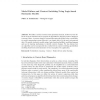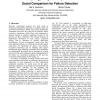171 search results - page 2 / 35 » Detecting Execution Failures Using Learned Action Models |
ICANN
2007
Springer
13 years 11 months ago
2007
Springer
We discuss evidence for the existence of mirror systems in the brain, including recent experimental results that demonstrate the use of shared pathways for the observation and exec...
ICRA
2007
IEEE
13 years 11 months ago
2007
IEEE
— One of the most notable and recognizable features of robot motion is the abrupt transitions between actions in action sequences. In contrast, humans and animals perform sequenc...
ECAI
2006
Springer
13 years 9 months ago
2006
Springer
Robust execution of robotic tasks is a difficult problem. In many situations, these tasks involve complex behaviors combining different functionalities (e.g. perception, localizat...
JCST
2010
13 years 8 days ago
2010
Abstract We define a notion of context that represents invariant, stable-over-time behavior in an environment and we propose an algorithm for detecting context changes in a stream ...
AGENTS
1998
Springer
13 years 9 months ago
1998
Springer
of other components. This abstract presents an implemented illustration of such explicit component synergy and its usefulness in dynamic multi-agent environments. In such environme...


